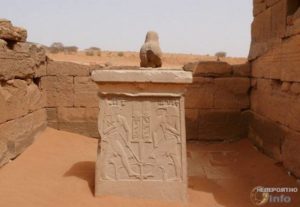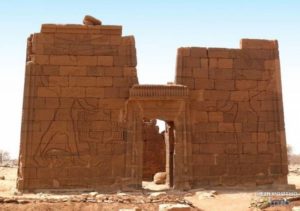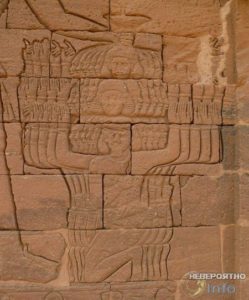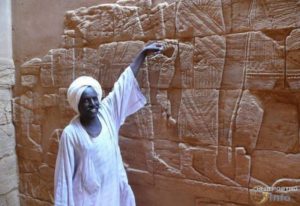
The mysterious civilization of Meroe
 1
1
 12. 11. 2017
12. 11. 2017

The Greeks adored them, the Egyptians and the Romans envied them. Thanks to archaeologists, the treasures of this mysterious civilization, which unfortunately disappeared forever, have finally been reborn from the sand, but at the same time they have kept their secrets.
South of Egypt, there are strange pyramids in the desert of present-day Sudan. Travelers usually think they are the work of the skilled hands of the ancient Egyptians. However, this is not the case.
If you take a closer look at these buildings, then you will find that neither the style nor the way they are made resemble the concept of the more well-known pyramids with a square base, although they stand close to the Nile. The pyramids are built of sandstone and reach a height of fifteen meters. As in the case of those Egyptian buildings, archaeologists try to interpret their primary purpose as tombs.
Everything in them, whether they are beautiful frescoes, dazzling decorations, ceramics, original vases depicting animals and all half covered with sand and limestone, speaks of the mysterious and magnificent civilization of Meroe.
This territory once belonged to Egypt and included the kingdom of Kush, in which the Nubians lived in the 6th century BC. The Egyptians and the Nubians constantly competed with each other, and armed clashes between them were not uncommon. By 591 BC, the Egyptians were so tired of such a troubled way of life that they left this territory and headed north, to the city of Napata.
At that time, the Kushites were ruled by King Aspalt, who went with his entire nation to the opposite side, south, to the Sixth Nile Cataract. The new place was protected both by the life-giving river itself and by its last tributary, the Altabara. It was here that the city of Meroe was founded, where the Kushites began to bury their kings.
The new kingdom was founded in the 3rd century. BC and over the following centuries experienced an incredible prosperity. Meroe has become a real fairytale place for people's lives. Here, literally, God himself sent the much-anticipated rain. This gift of fate gave the inhabitants the possibility to live independently of the waters of the Nile.
In addition, the migrants found about eight hundred open-water reservoirs at this place! Thanks to the water, the locals to whom the Kushites moved could plant sorghum and raise bulls and elephants. The inhabitants of Meroe began to mine gold, grow fruit trees, make statues of ivory…
They sent their goods in caravans to Egypt, to the Red Sea and to Central Africa. And their products were truly stunning! How much did Queen Amanishacheto's jewels, stolen from her tomb by the Italian impostor Ferlini, cost! There were dozens of bracelets, rings, decorative gold patches…
A little of it has survived. Whether it is the head of a statue depicting a man with remarkably subtle facial features, created in the 3rd - 1st century. BC, found by Spanish archaeologists in 1963, or the bronze king of the Kushites (from the 2nd century BC), whose position of the hands indicated that he once held a bow in them! Or a statue of the god Sebiumechar, which adorned the entrance to one of the temples of Meroe, or, for example, a blue glass goblet decorated with gold, which was found in Sedeinze. In accordance with the funeral ritual, it was broken into forty pieces…
People with flaming facesas the Greeks called them, they captured the geniuses of antiquity. For example, Herodotus already mentioned the Great City in the desert and described the camels walking in it as animals with four toes on their hind legs. Maybe it was an illusion…
The Greek geographer and traveler Strabo described Queen Kandaka of Meroe as hunched, one-eyed and brave. Her portrait was found on the walls of the Lion Temple in the city of Naqa, which lies south of the capital. This is one of the many traces of Meroi art indicating that it was the first African civilization.
Francis Gesi thinks that Meroe is completely different from Egypt. They came from foreign regions and were able to create an original civilization here. For example, it is not possible to confuse buildings built by them with Egyptian or Greek or Roman buildings. Its inhabitants created their own art, which was unlike anything at all.
They left the Greek pantheon to worship the new God is lying with the head of Apedemak. He was considered a patron of Nubian soldiers.
Catherine Berger, Meroian culture specialist and director of the Archaeological Mission in Sudan, thinks that the god with the head of a lion rules the empire together with the ram Amon. (the ram was the sacred animal of Amon), but it retains its Egyptian appearance and the Sudanese Apedemak. God in the form of a lion leads battles and represents a symbol of victory.
By the way, the inhabitants of Meroe had a rather strange mixture of religion. They worshiped both Apedemak and Ammon simultaneously. Perhaps it was the influence of the Egyptians who had ruled the Kusites for many years, and they were descendants of the Meroe's inhabitants. As for the female figures painted on wooden plates and fastened on the facades of the temples, they do not at all resemble the beautiful Egyptian beauties. Meroy women, on the contrary, were characterized by lush shapes.
The Royal City of Meroe was found by archaeologists at the beginning of 19. century. Since then excavations have widened. Thanks to Egyptian documents testifying to mysterious Nubians, archaeologists began to recognize his history.
No one yet knows how and why the kingdom disappeared in the first half of the 4th century AD. In 330, the first Christian king found Aksum (Ethiopia) during one of its marches of the ruins of the city of Meroe. We could learn about what happened to the mysterious civilization from the Meroitic texts collected by archaeologists in almost two hundred years. However, they have not yet been decrypted, as no key has been found to decipher the Mero language.
This desert Atlantis, as Meroe is sometimes called, seems to have buried its secrets in the depths of the sands. Archaeologist Francis Gesi assumes that in the 3rd century. nl, its rulers began to pay too much attention to neighboring areas, thus dispersing their forces, and this led first to glorification and then to its destruction.
Egyptologists are still puzzled by her tongue. The Englishman Griffith was the first to reconstruct their alphabet in 1909, thanks to bilingual inscriptions on the stelae. The second language besides Meroji was the language of the ancient Egyptians. Other researchers then added to the alphabet. French researcher Jean Leclant thinks it is made up of twenty-three letters. But using it really was very difficult. The deciphered words didn't make sense. The names of kings and gods were only roughly deciphered… Even with the help of a computer, Jean Leclant and his colleagues, who collected thousands of texts and used all the possibilities of modern technology to compose various combinations of words, failed to achieve results.
The secret of the language of this civilization has not yet been revealed, which means that the kingdom of Meroe itself, its essence and laws are not yet subject to human reason…














